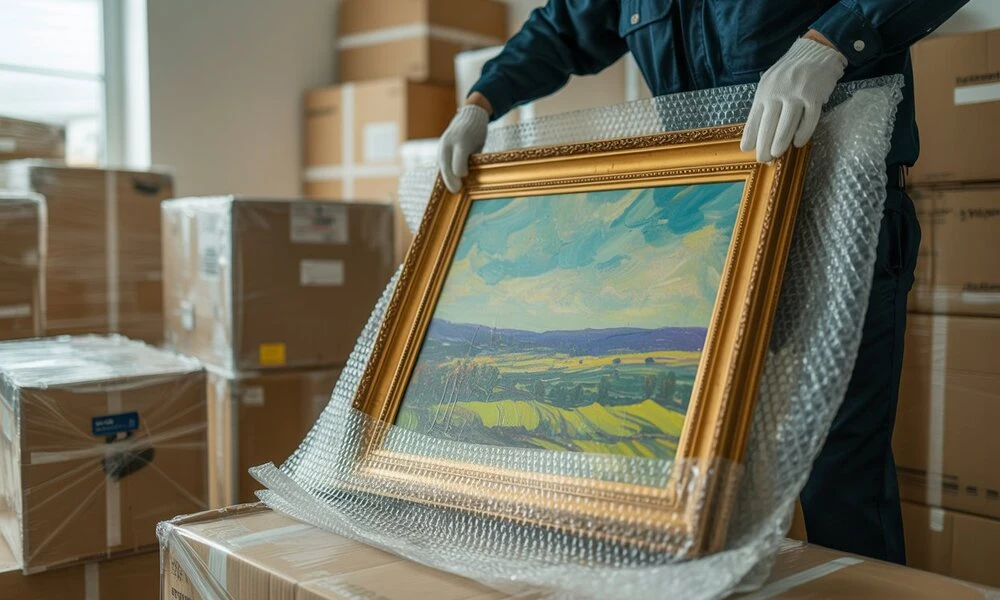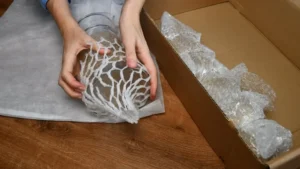How to pack paintings for moving is an important process to protect your artwork during a relocation. Whether you’re a homeowner or an art collector, paintings are delicate and can easily be damaged if not handled correctly. Scratches, broken frames, smudges, and tears are common issues when packing paintings for moving without proper care.
Using the right materials—like glassine paper, bubble wrap, and picture boxes—is key to keeping your art safe. Packing art for moving requires a thoughtful approach, not just placing it in any box. This guide is designed to help anyone moving with artwork, from casual collectors to gallery owners. We’ll walk you through the best practices step by step. Protecting your investment starts with how you pack it.
Equipment and Tools Required for Packing of Paintings

When it comes to packing paintings, using the right tools and materials is essential to protect them from scratches, dents, and moisture during transport. Whether you’re handling framed art or canvas, this guide outlines the necessary packing supplies, protective materials, and tools for fragile items used in the moving and logistics industry.
Essential Packing Supplies
Glassine Paper or Wax Paper
Prevents the painted surface from sticking or smudging. Ideal as the first layer of protection.
Acid-Free Paper
Used for wrapping artwork to avoid long-term damage such as yellowing or chemical reactions.
Bubble Wrap
Provides cushioning and absorbs shock. Wrap over protective paper, not directly on the painting.
Painter’s Tape
Secures wrapping materials without leaving residue or damaging the frame.
Cardboard Sheets
Adds a rigid protective barrier to prevent bending or impact.
Packing Tape and Stretch Wrap
Keeps layers sealed and offers added moisture resistance during moving.
Corner Protectors
Shields frame edges from damage, especially useful for glass-covered artwork.
Mirror or Picture Boxes / Custom Crates
Designed to hold flat, fragile items like paintings securely. Custom crates are preferred for high-value or oversized art.
Optional Packing Tools
Measuring Tape
Ensures accurate box sizing and fitting of materials.
Labeling Tools
Markers or labels help identify fragile contents and proper orientation.
Foam Boards or Padding
Used inside boxes for extra cushioning or to separate multiple artworks.
Gloves
Prevents oils or dirt from transferring to the artwork or frame during handling.
Best Ways of How to Pack Paintings for Moving

When it comes to moving fragile items like paintings and canvas art, proper packing techniques are essential. Artwork is delicate, valuable, and easily damaged by moisture, impact, or movement during transport. Whether you’re moving locally or long-distance, knowing how to pack paintings for moving can help protect your cherished pieces from harm.
At Chamomile Go, we specialize in careful handling of fragile items through our expert packing services in Sherman Oaks and nearby areas. This guide will show you the safest step-by-step methods for packing art for moving, including framed and unframed paintings.
Step-by-Step Guide: Packing Paintings for Moving
1. Clean and Inspect the Painting
Before you begin packing pictures for moving, lightly dust the surface using a soft brush or cloth. Inspect the painting for any existing damage. It’s important to note any issues beforehand, especially for insurance purposes.
2. Apply Glassine Paper or Acid-Free Tissue
Cover the artwork surface with a protective layer like glassine paper or acid-free tissue. These materials shield your artwork from moisture, dust, and abrasion, which is critical when packing canvas art for moving.
3. Use Bubble Wrap for Cushioning
After covering with protective paper, wrap the entire painting in bubble wrap. This adds a cushioning layer to absorb shocks. For extra safety, double-wrap the edges and corners, which are usually the most vulnerable points.
4. Secure Corners with Corner Protectors
Use foam or cardboard corner protectors to safeguard the edges. These help prevent frame damage and provide more structure, especially important when packing paintings for moving in high-risk environments.
5. Sandwich Between Foam Boards or Cardboard
To keep the painting flat and minimize movement, place it between two sturdy foam boards or cardboard sheets. Tape the boards together gently without pressing against the artwork.
6. Place in a Picture Box or Custom Crate
Slide the protected painting into a picture box or wooden crate designed for framed art. Use packing paper or soft filler around the edges to prevent shifting inside the box. This is one of the most effective techniques when packing art for moving safely.
7. Seal and Label the Box as “FRAGILE – ARTWORK”
Use strong packing tape to seal the box tightly. Clearly label all sides with “FRAGILE – ARTWORK” and indicate the upright position. Also include handling instructions like “Do Not Stack” or “Keep Dry” for extra awareness.
Tips to Prevent Moisture, Impact, and Movement
- Avoid plastic wrap directly on artwork—it can trap moisture.
- Don’t pack paintings with regular household items. Always keep them separate.
- Use silica gel packets inside the box to reduce humidity.
- Store upright and avoid stacking heavy items on top.
- Handle with two hands and avoid placing pressure on the canvas or frame.
Importance of Labeling and Handling Instructions
Labeling is one of the most overlooked but crucial steps in packing pictures for moving. Movers or even family members need to know that the box contains fragile artwork. A simple label like “Handle with Care” can reduce the chances of accidental drops or mishandling during the move.
Let Chamomile Go Handle Your Artwork with Care
If you’re unsure about packing canvas art for moving, leave it to the professionals. At Chamomile Go, we provide expert packing services in Sherman Oaks designed to protect even your most delicate artwork. Our team uses industry-approved materials and techniques to ensure every piece of art arrives safely at your new location.
Whether you’re a homeowner, artist, or collector, we’re here to take the stress out of moving your fragile items. Trust Chamomile Go to pack your paintings like pros.
How to Pack Canvas Paintings for Moving
Packing canvas art for moving requires special care due to the delicate surface and frame. Whether you’re relocating your home or gallery collection, it’s important to use proper methods that prevent damage during transport.
Understand the Material and Frame Type
Canvas paintings can be framed or unframed, stretched over wood, or mounted. Knowing the type helps decide the best wrapping and packing approach for safe art transportation.
How to Wrap Unframed vs Framed Canvas Art
For unframed canvas, place acid-free tissue or glassine paper over the artwork, followed by a layer of bubble wrap. For framed canvas art, cover the glass (if any) with painter’s tape in an X-pattern, then wrap the entire piece carefully.
Avoid Pressure on the Canvas Surface
Never let packing materials press directly against the canvas. This can dent or stretch the fabric. Instead, use cardboard or foam board as a flat buffer layer on both sides before wrapping.
Use Corner Protection and Layering Techniques
Add corner protectors to prevent crushing or frame damage. Sandwich the painting between two sturdy boards to maintain structure and reduce movement—a smart method when packing pictures for moving.
How to Safely Stack Multiple Canvas Pieces
If stacking is necessary, place the largest, flattest canvas at the bottom and separate each with cardboard or foam sheets. Never let the painted surfaces face each other directly.
Best Positioning in the Moving Truck or Container
Keep canvas paintings upright and against a flat, secure surface in the moving truck. Avoid placing them under heavy items. Mark boxes clearly with “FRAGILE – CANVAS ART” for visibility.
How to Pack Oil Paintings for Moving
Oil paintings are beautiful but delicate, especially during a move. These artworks are highly sensitive to temperature changes, humidity, and direct contact. When packing paintings for moving, special care must be taken to preserve their surface and structure.
Understand the Challenges with Oil Paintings
Oil paint can remain soft or tacky for months, making it prone to smudging, cracking, or sticking. Sudden changes in temperature or poor packing can easily damage the piece. That’s why packing art for moving requires more than just basic materials.
Never Use Plastic Wrap Directly on the Surface
Avoid wrapping oil-painted surfaces in plastic, as it traps moisture and can stick to the paint. This can cause permanent damage to the artwork.
Use Glassine Paper for Surface Protection
Start by gently placing a sheet of glassine paper over the painted surface. It’s non-stick, pH-neutral, and breathable—perfect for oil-based artwork.
Double Wrap with Padding
After applying glassine paper, wrap the painting in bubble wrap or soft foam for cushioning. This protects the piece from impact without touching the paint directly.
Use Climate-Safe Materials or Containers
Choose a picture box, wooden crate, or insulated container, especially for long-distance or climate-sensitive moves. These options help regulate temperature and protect from sudden environmental changes.
Considerations for Long-Distance or Storage Moves
If storing oil paintings or moving them over long distances, avoid attics or basements. Choose dry, climate-controlled environments to prevent warping or mold buildup.
Hire Specialty Movers for Expensive Pieces
If the oil painting is valuable or irreplaceable, hiring specialty movers or fine art handlers is the safest option. They have the experience and equipment for packing paintings for moving with maximum preservation in mind.
When to Hire Professional Art Movers
Moving artwork isn’t just about packing—it’s about preservation. If you’re dealing with high-value, antique, or sentimental paintings, hiring professional art movers is a smart investment.
Consider expert help for:
- Long-distance or cross-country moves, where bumps, shifts, and temperature changes pose real risks.
- Climate-sensitive artwork that requires temperature-controlled transportation to prevent cracking or warping.
- Custom crating and full insurance, ensuring your art is protected from start to finish.
At Chamomile Go, we offer trusted packing and moving support in Sherman Oaks, including care for fine art and fragile items. Moving valuable artwork? Contact us today for secure, professional handling.
FAQs
1. What Materials Do I Need To Pack A Painting Safely?
To pack a painting properly, you’ll need glassine paper or acid-free tissue, bubble wrap, corner protectors, foam boards or cardboard, and a sturdy picture box or crate. Avoid using plastic wrap directly on the artwork.
2. Can I Use Bubble Wrap Directly On The Painting?
No. Never place bubble wrap directly on the surface of a painting, especially oil or acrylic art. Always use glassine paper or acid-free tissue first to avoid sticking or surface damage.
3. How Do I Pack Canvas Art For Moving?
Start by covering the surface with glassine paper, then use bubble wrap and foam boards for protection. Secure the corners and place the piece in a picture box. If stacking, separate each piece with cardboard. This method works well for packing canvas art for moving.
4. Should Paintings Be Moved Flat Or Upright?
Always move paintings upright to prevent pressure on the canvas. Keep them against a flat, stable surface and avoid stacking heavy items on top.
5. How Do I Label Artwork Boxes For Moving?
Clearly mark all sides of the box with “FRAGILE – ARTWORK”, “This Side Up,” and “Handle with Care.” Proper labeling helps prevent rough handling during transport.








